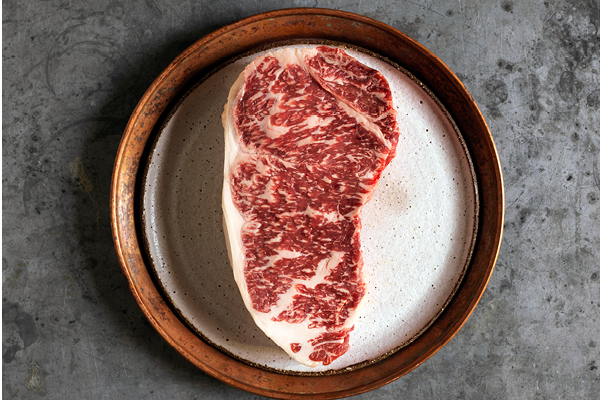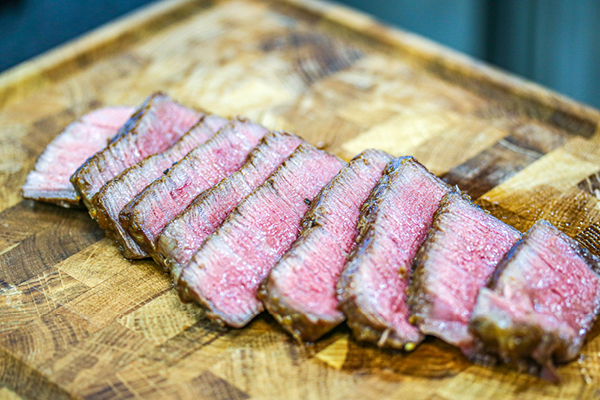The Classic Butcher Basics of Cooking a Perfect Steak
To cook a perfect steak it is such a dilemma, and there are so many arguments on how to do it. Today, we will walk you through the main steps you need to take in order to accomplish your goal. We've got simple steps for you from our in-house butcher Richard so you can achieve the perfect cooked steak. so you can achieve the perfect cooked steak.

Take Your Steak Out 1 Hour Before Cooking
You want your steak to cook evenly from edge to centre. Your steak has been in a cold fridge for hours and needs to reach an even, warm temperature throughout before cooking, so the outside of the meat does not burn, and the inside isn't cold.
Have Your Ingredients Ready
- Salt - You can use all sorts of different salts to season your steak. You have kosher salt, sea salt, rock salt, Terre Exotique Pink Himalayan salt but keep away from the iodized stuff. Find the great selection of seasonings here
- • Pepper – Freshly cracked or ground pepper is the most popular, never white pepper but try green sometimes for more of a tasty change.
- Unsalted butter - You want to have complete control over the flavour in your recipe, you want to use unsalted butter such as Bordier as salted butter can taint the final taste.
- Oil – Flavourless oils like sunflower, vegetable or groundnut work best, and once the steak is seared you can add butter to the pan for flavour. The oil will help the butter not to burn.
- Garlic – (optional) lightly crushed cloves skin on, will give your steak a lovely nutty flavour.
- Fresh Herbs – (optional) Fresh Thyme and Rosemary will give a beautiful fragrant taste.
Season Your Steak Generously
Don’t be shy when seasoning your steak. You will lose 30-40% of the seasoning during the cooking process. Using fresh sea salt and black pepper, rub all over the sides of the steak, including the thin sides and most importantly the fat side to help with the caramelization.
Invest In a Good Pan or Skillet
Using good cast iron skillet or a high-quality stainless-steel pan will insure an even heat across the base of the pan. Give it time to heat up to a high-medium temperature.
To test, drip some water in the pan, the water will bead up in a single ball, if the water hits the pan and "shatters" into a bunch of small beads, it's too hot.
Place Your Steak In The Pan Away From You
Add oil to the pan and spread it around covering the surface.
Place your steak away from you, so the hot oil does not spit up at you.
Remember if there is no LOUD SIZZLE it’s not hot enough.
Sear Your Crust On Your Steak
If you have seasoned your steak well, the correct heat from the pan will create a beautiful brown crust around your steak, sealing in all the juices and flavours. Usually (depending on the thickness) this takes 1.5 – 2 mins per side.
Do not forget to sear the sides and also the fat if you’re cooking steaks such as sirloin, T bone or rump.
Time To Baste Your Steak
Timing is crucial, to cook your steak usually without basting it would take 3-4 mins per side for a 300g/10oz sirloin steak for medium. So now its time to add your extra ingredients.
Add a good Tsp of butter with your garlic cloves and swirl the butter around the pan for 30s
Add your fresh herbs, mixing with your butter and garlic, combine those flavours together.
Turn your steak over, tip your pan on its side so the butter pools and then with a spoon start to baste your steak over and over.
Flip your steak 3 more times after each baste and then take off after 2 minutes.
Rest Your Steak
This is where it can all go wrong if you cut into your steak too soon.
Once finished, take your steak out and let it rest for 6-8 minutes on a wooden board.
Don’t touch it, don’t cut it, don’t even look at it!
The juices in your steak are still bubbling and still hot as they cool down, if you cut into it too soon, all those juices will run out leaving you a dried out, flavourless piece of meat and all that hard work gone to waste …. So make sure you rest it well!

What Temperature To Cook My Steak?
Always an interesting topic. As a rule you want to cook grass fed beef to medium rare (45C) and grain fed beef to medium (50C)
The reason for this is that grass fed beef has obviously less intramuscular fat commonly known as “Marbling” which you would find more in grain/corn fed beef or Wagyu beef.
You want grass fed beef to stay moist and not to dry out, so medium rare is best
For the more marbled grain fed beef, you want to give the fat inside your steak the chance to melt to give you a buttery, creamy taste throughout the steak.
There’s a lot of different methods to test steak to know if its cooked correctly, we recommend taking all the guessing work out and use a good thermometer to get the right temperature.
Rare 120°F to 125°F 45°C to 50°C
Medium-Rare 130°F to 135°F 55°C to 60°C
Medium 140°F to 145°F 60°C to 65°C
Find Richard's selection of steaks here





